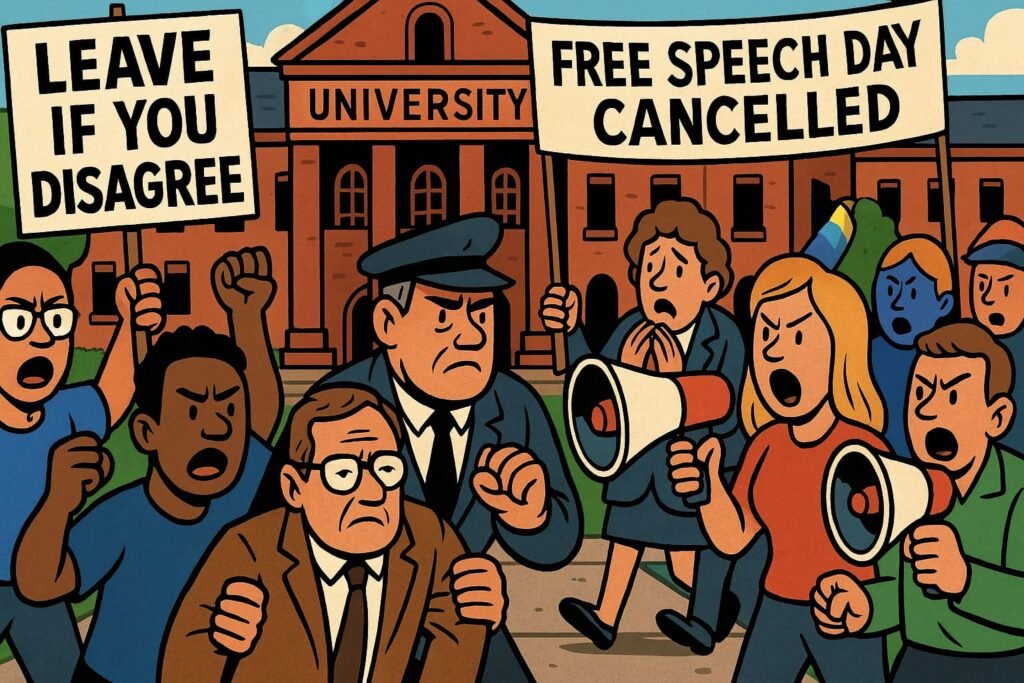Evergreen State College Explained – Free Speech Cancelled
In 2017, a small liberal arts college in Washington State managed to stage a dress rehearsal for the culture wars. Evergreen State College wasn’t just another protest story — it became a symbol of how quickly social justice activism can turn a campus into an ideological battleground.
The punchline? A “Day of Absence” meant to promote inclusion ended up chasing free speech off campus.
Table of contents
What Sparked the Evergreen Protests
For years, Evergreen held a symbolic “Day of Absence,” where minority students voluntarily left campus to highlight their contributions. In 2017, organisers flipped the script: this time, white students and faculty were asked to leave instead.
Bret Weinstein, a biology professor, objected. He argued the new version wasn’t voluntary absence but compulsory exclusion — closer to segregation than solidarity.
From Day of Absence to Day of Outrage
Weinstein’s email dissent triggered outrage. Students accused him of racism, stormed classrooms, and demanded his resignation. What should have been a debate turned into a campus-wide meltdown.
The irony? A protest meant to showcase diversity became an exercise in enforced conformity.
The Weinstein Affair
Weinstein tried to explain that he supported the old Day of Absence, but opposed flipping it into a ban on certain races. His attempts at reason only made things worse.
Students surrounded him, shouted him down, and circulated demands: his firing, sensitivity training, and sweeping diversity measures. Evergreen’s biology professor became Evergreen’s heretic.
Administration in Retreat
College president George Bridges sided with the protesters. His public appearances — often flanked by chanting students — gave the impression of an administration held hostage by its own ideology.
Instead of defending academic freedom, Evergreen leaders let mob politics dictate campus policy. Free speech became negotiable.
Fallout: Decline and Departure
The aftermath was brutal. National media turned Evergreen into a cautionary tale of campus radicalism. Enrolment plummeted. Weinstein resigned and reached a settlement with the college.
Evergreen didn’t just lose a professor. It lost credibility, students, and its claim to be a marketplace of ideas.
Why Evergreen Still Matters
Evergreen wasn’t unique. It was an early glimpse of what would spread across campuses:
- Speech codes dressed up as inclusivity.
- Mandatory ideology presented as education.
- Weak leadership folding to the loudest activists.
Evergreen showed how quickly a university can become an echo chamber — and how fragile academic freedom is when administrators surrender to slogans.
The Day the Students Left
Evergreen State College wanted to send a message about inclusion. Instead, it told dissent to get off campus — and the students followed. What was supposed to be a celebration of diversity became a cautionary tale of conformity.
Related Reading:
FAQ
What was Evergreen’s Day of Absence?
Originally, a voluntary event where minority students left campus to highlight their presence. In 2017, it was changed to request white students and faculty to leave instead.
Who was Bret Weinstein?
A biology professor who opposed the new format of Day of Absence, arguing it was coercive. He became the central figure in the controversy.
Why did Evergreen face backlash?
Because the administration capitulated to activist demands, silencing dissent and undermining free speech.
What happened after the protests?
Enrolment declined sharply, Weinstein resigned with a settlement, and Evergreen became a national symbol of campus radicalism.



